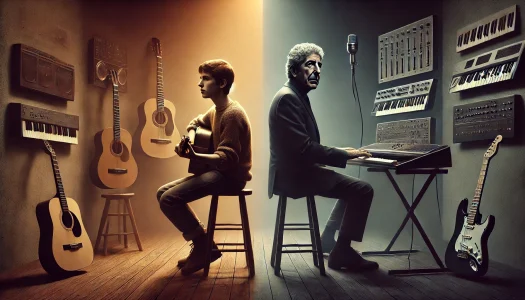Leonard Cohen stands as one of the most revered figures in modern music, celebrated for his profound lyricism, rich baritone voice, and an uncanny ability to weave poetry into song. Emerging in the late 1960s amidst the folk music revival, Cohen quickly distinguished himself as a master storyteller whose work transcended the confines of genre. Over his five-decade career, he evolved from a minimalist balladeer to a sophisticated architect of sound, embracing orchestral arrangements, synthesizers, and contemporary production techniques.
Early Years: The Folk Balladeer (1960s)
Leonard Cohen’s musical journey began against the backdrop of the 1960s folk revival, a movement defined by its emphasis on storytelling and social consciousness. A published poet and novelist before venturing into music, Cohen entered this scene as an outsider, bringing a literary sensibility that set him apart from his contemporaries.
Cohen’s debut album, Songs of Leonard Cohen (1967), introduced his signature minimalist style, marked by acoustic guitar, subtle arrangements, and an emphasis on evocative, introspective lyrics. Tracks like “Suzanne” and “So Long, Marianne” exemplify his ability to blend deeply personal narratives with universal themes of love, longing, and spirituality.
His early work was stark yet hauntingly beautiful, drawing listeners into intimate worlds with an economy of sound that left space for his words to resonate. This era established Cohen as a master of the folk ballad, creating timeless songs that continue to captivate audiences.
Experimentation and Expansion (1970s)
In the 1970s, Leonard Cohen began to expand his sonic palette, moving beyond the stark minimalism of his early work. This period saw him experiment with fuller arrangements, incorporating strings, horns, and choral elements that added depth and drama to his songs. While his lyrics remained as introspective and poetic as ever, the broader instrumentation brought a heightened emotional intensity to his music.
A pivotal figure in this evolution was producer Bob Johnston, who worked with Cohen on Songs of Love and Hate (1971). Johnston’s influence can be heard in the album’s lush, melancholic textures, particularly on tracks like “Famous Blue Raincoat,” where delicate strings and layered harmonies underscore the song’s haunting narrative.
Cohen continued to refine his sound on New Skin for the Old Ceremony (1974), a record that introduced bolder instrumentation, including orchestral flourishes and exotic rhythms. This album showcased his willingness to push boundaries while maintaining his core identity as a songwriter.
The Synth Era: Reinvention in the 1980s
By the 1980s, Leonard Cohen found himself navigating a rapidly evolving musical landscape dominated by synthesizers and electronic production. Rather than resist these changes, Cohen embraced them, reinventing his sound while retaining the poetic depth that defined his artistry. This period saw the introduction of synthesizers, drum machines, and atmospheric textures, giving his music a modern edge that appealed to a new generation of listeners.
Collaborators played a significant role in this transformation, particularly Jennifer Warnes, whose vocal harmonies and creative input added richness to Cohen’s sound. Warnes’ contributions were especially notable on Various Positions (1984), which featured the now-iconic “Hallelujah.” Although initially overlooked, the song became a cultural touchstone, its sparse yet emotive arrangement blending traditional and contemporary elements.
Cohen’s reinvention reached its zenith with I’m Your Man (1988), a masterful embrace of synth-driven pop. Tracks like “First We Take Manhattan” showcased his ability to pair brooding, sardonic lyrics with propulsive electronic beats and layered production.
Late Career: A Return to Intimacy (1990s–2010s)
In his later years, Leonard Cohen’s music took on a renewed sense of intimacy, marked by stripped-back arrangements and an unflinching exploration of mortality, spirituality, and the human condition. This phase balanced the modern production techniques he had embraced in the 1980s with a return to the poetic subtlety of his early work, resulting in some of the most profound and reflective music of his career.
The Future (1992) carried echoes of his synth-era experimentation but introduced a darker, more apocalyptic tone in tracks like “The Future” and “Anthem.” As Cohen’s voice grew deeper and more gravelly, it became a vessel for his meditations on societal collapse and personal redemption.
By the 2000s, Cohen had further refined his approach, as seen in Ten New Songs (2001). Co-written with Sharon Robinson, the album featured sparse yet lush arrangements that complemented Cohen’s introspective lyrics and world-weary delivery. Songs like “In My Secret Life” showcased his ability to blend emotional depth with quiet sophistication.
Cohen’s final album, You Want It Darker (2016), was a haunting farewell, released just weeks before his death. Its stark production and gospel-infused undertones highlighted themes of acceptance and transcendence, with the title track serving as both a confession and a benediction.
Closing Thoughts
Leonard Cohen’s sonic journey stands as a testament to his unwavering commitment to artistic growth. From the barebones intimacy of his folk ballads in the 1960s to the lush orchestrations and synth-driven experiments of later decades, Cohen continually redefined his sound while staying true to his core as a poet and storyteller. His ability to evolve—embracing new musical landscapes and collaborators—ensured that his work remained relevant, resonant, and deeply human across generations.
Cohen’s sound shifts were not mere stylistic choices; they mirrored the evolution of his artistry and his engagement with the changing cultural currents of his time. Each phase of his career reflected his deep curiosity about both the inner workings of the soul and the broader questions of existence. In adapting to new tools and technologies, Cohen’s music maintained a timeless quality, speaking to both the struggles and the beauty of life.
